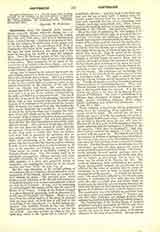

Conversion (from the classical Latin converto, depon. convertor, whence conversio, change, etc.), in the Latin Vulgate (Acts, xv, 3), in patristic (St. Augustine, Civ. Dei, VIII, xxiv), and in later ecclesiastical Latin, a moral change, a turning or returning to God, to the true religion, in which sense it has passed into our modern languages: the conversion of St. Paul, of Constantine the Great, of St. Augustine. In the Middle Ages the word conversion was often used in the sense of forsaking the world to enter the religious state. Thus St. Bernard speaks of his conversion. The return of the sinner to a life of virtue is also called a conversion. More commonly do we speak of the conversion of an infidel to the true religion, and most commonly of the conversion of a schismatic or heretic to the Catholic Church.
Every man is bound by the natural law to seek the true religion, embrace it when found, and conform his life to its principles and precepts. And it is a dogma of the Church defined by the Vatican Council that man is able by the natural light of reason to arrive at the certain knowledge of the existence of the one true God, our Creator and Lord. The same council teaches that faith is a gift of God necessary for salvation, that it is an act of the intellect commanded by the will, and that it is a supernatural act. The act of faith then is an act of the understanding, whereby we firmly hold as true whatever God has revealed, not because of its intrinsic truth perceived by the natural light of reason, but because God, who can neither deceive nor be deceived, has revealed it. It is in itself an act of the understanding, but it requires the influence of the will which moves the intellect to assent. For many of the truths of revelation, being mysteries, are to some extent obscure. Yet, it is not a blind act, since the fact that God has spoken is not merely probable but certain. The evidences for the fact of revelation are not, however, the motive of faith; they are the grounds which render revelation credible, that is to say, they make it certain that God has spoken. And since faith is necessary for salvation, that we may comply with the duty of embracing the true Faith and persevering in it, God by His only-begotten Son has instituted the Church and has adorned it with obvious marks so that it may be known by all men as the guardian and teacher of revealed truth. These marks (or notes) of credibility belong to the Catholic Church alone. Nay, the Church itself by its admirable propagation, sublime sanctity, and inexhaustible fecundity, by its Catholic unity and invincible stability, is a great and perpetual motive of credibility and irrefragable testimony of its Divine mission (see Conc. Vatic., De Fide, cap. 3).
The first step, therefore, in the normal process of conversion is the investigation and examination of the credentials of the Church, which often is a painful labor lasting for years. The external grace which draws a man’s attention to the Church and causes him to begin his inquiry is as various and manifold as there are individual inquirers. It may even be something to one’s temporal advantage, which was the case with Henry IV of France. It may be the interest aroused in a great historical personage, such as Innocent III, in the case of Friedrich von Hurter. Whatever may have been the initial motive, if the study be pursued with an open mind, we hold that it will lead to the knowledge of the true Church, i.e. to this certain conclusion: The Catholic Church is the true Church. This intellectual conviction, however, is not yet the act of faith. One may hesitate, or refuse to take the next step, which is the “good will to believe” (pius credulitatis affectus). And this leads to the third and final act, the act of faith itself: I believe what the Church teaches because God has revealed it. These three acts, especially the last, are, in accordance with Catholic teaching, supernatural acts. Then follows baptism by which the believer is formally received into the body of the Church. (See Baptism.)
Since the duty of embracing the true religion is of natural and positive Divine right, it is evident that no civil law can forbid the fulfilling of this duty, nor should any temporal considerations be allowed to interfere with a duty on which depends the soul’s salvation. And because all are bound to enter the Church, it follows that the Church has a right to receive all who apply for reception, of whatever age, sex, or condition they may be. Nay, in virtue of the Divine command to preach the Gospel to every creature, the Church is strictly bound to receive them, and no earthly authority can forbid the exercise of this duty. To the Church alone it belongs to lay down the conditions for reception and to inquire into the interior dispositions of him who presents himself for admission into her bosom. The conditions are, knowledge and profession of the Catholic Faith and the resolve to live in accordance with it. The right to admit converts into the Church belongs strictly speaking to the bishop. Usually all priests exercising the sacred ministry receive faculties for reconciling heretics. When conditional baptism is administered, sacramental confession is also required from the convert. It is the law clearly laid down in the Acts of the Second Plenary Council of Baltimore. The order of proceedings is as follows: first, abjuration of heresy or profession of faith; second, conditional baptism; third, sacra-mental confession and conditional absolution. (Tit. V, Cap. II, n. 240.)
Force, violence, or fraud may not be employed to bring about the conversion of an unbeliever. Such means would be sinful. The natural law, the law of Christ, the nature of faith, the teaching and practice of the Church forbid such means. Credere voluntatis est, to believe depends upon the free will, says St. Thomas (II—II, Q. x, a. 8), and the minister of baptism, before administering the sacrament, is obliged to ask the question, “Wilt thou be baptized”? And only after having received the answer, “I will”, may he proceed with the sacred rite. The Church also forbids the baptism of children of unbaptized parents without the consent of the latter, unless the children have been cast away by their parents, or are in imminent danger of death. For the Church has no jurisdiction over the unbaptized, nor does the State possess the power of using temporal means in spiritual things. The punishments formerly decreed against apostates were not intended to coerce men to accept outwardly what they did not believe in their hearts, but to atone for a crime (see the article of St. Thomas, loc. cit.). The medieval legislation, both ecclesiastical and secular, clearly distinguished between the punishment to be inflicted for the crime of apostasy and the means of instruction to be used in order to bring about the resipiscence of the apostate. As Bishop von Ketteler says, “The punishment inflicted by the Church upon heretics in comparatively few cases was not based upon the false principle that conviction could be forced upon the mind by external means, but upon the truth that by baptism the Christian has assumed obligations the fulfilment of which could be insisted upon. This punishment was only inflicted in particular cases and upon public and formal heretics.” Convert parents like other Catholics are obliged to have their children baptized and educated in the Catholic religion.
The Constitution of the United States of America proclaims complete separation of Church and State and guarantees full liberty of conscience. In cones quence the laws of these States place no hindrance whatever in the way of conversions. It may also be said that on the whole the American people are socially tolerant towards converts. No wonder that in this country conversions are comparatively more numerous than in any other. In the British Empire too, since the days of Catholic Emancipation in 1829, liberty of conscience prevails in theory as well as in practice, although there exists both in England and Scotland an established Church. Catholic disabilities have been almost entirely removed. Catholics are only excluded from the throne and from a few of the highest offices of the State. In Germany after the Reformation the tyrannical principle cujus regio, illius religio was proclaimed, in virtue of which the sovereign for the time being could impose his religion upon his subjects. He exercised the power both to forbid conversions to the Catholic Church, and to compel apostasy from it. In the present German Empire, where nearly two-thirds of the population is Protestant, liberty of conscience is the law of the land. And although union of Church and State exists, conversion does not involve any disabilities or the loss of any civil or political rights. In some of the States, however, the rights guaranteed by the empire are somewhat restricted by State laws. Most of the States prescribe the age before which conversions are not lawful, which is either fourteen or sixteen, or even eighteen. In Saxony, Brunswick, and Mecklenburg, the public exercise of the Catholic religion is subjected to vexatious interference. In Russia the Greek-Orthodox is the State religion, other denominations are only tolerated. For long conversion from the Orthodox Church to Catholicism was followed by grievous disabilities. By the ukase of 1905 certain rights and liberties were granted to other denominations. The publication of the ukase was immediately followed by the return to the Catholic Church of many Uniats who had been forced into schism by persecution. The Scandinavian countries were very intolerant till about the middle of the nineteenth century. Denmark gave liberty to the Catholic Church in 1849, Sweden and Norway in 1860.
B. GULDNER


